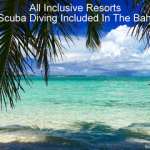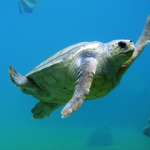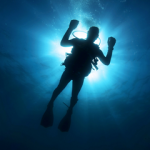
There’s no better way to dive the Bahamas than on a Bahamas liveaboard dive boat cruise
Not only is the Bahamas a beautiful place to visit, but the scuba diving is amazing too. Bahamas liveaboard dive boats are an even better way to see the amazing underwater world of beauty too. The waters of the Bahamas are spectacular, even from space as shown in the above image of the Great Exumas Islands.
The best way to scuba dive the Bahamas is from a Bahamas liveaboard dive cruise. The Bahamas has year-round warm seas and mild air temperatures, healthy coral reefs and abundant sea life. But it’s also one of the best places to dive with tiger sharks, reef sharks, tiger sharks and bull sharks.
The best way to dive the Bahamas is by a scuba diving liveaboard. You can check the latest and best deals on Bahamas liveaboards using the following window:
The Bahamas is also known for ship wrecks, ocean whitetip sharks, as well as for diving on stunning sea walls and it has one of the top blue holes to dive in the world.
This article includes two handy tables. The first is a list of the Bahamas liveaboards, including those that visit Tiger Beach. The second is a table of Bahamas weather, air temperature, water temperature and the best time to scuba dive the Bahamas.
Where are the Bahamas in the Caribbean?
The Bahamas are in the Caribbean and at the closest point the islands of the Bahamas are situated about 56 miles (90km) east off the US Florida coast. That means the waters are warm throughout the year.
There are better times to visit the area and other times to avoid if you’re looking for sun and not rain. Although when it does rain in the Bahamas, it’s warm rain. Or as the locals call it ‘liquid sunshine.’
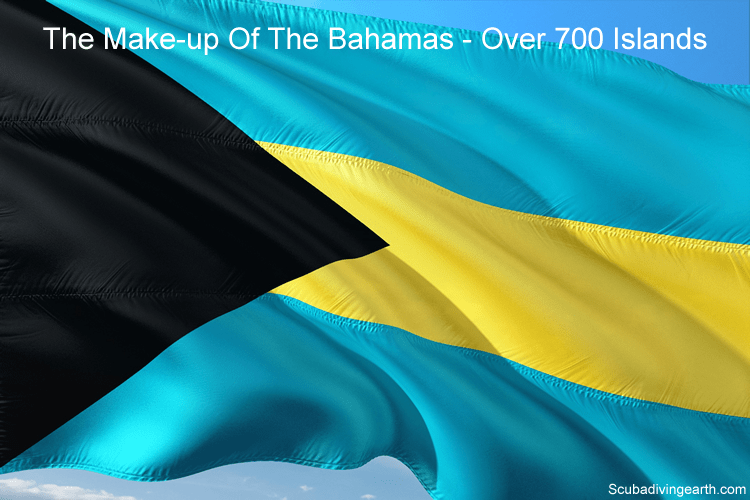
The islands of the Bahamas
The Bahamas are made up of 700 islands (of which 30 are uninhabited), and 2,500 cays. These islands and cays form the Commonwealth of the Bahamas. The Bahamas is referred to as an archipelagic state.
The capital of the Bahamas is Nassau, which is located on the island of New Providence. In 1718 the Bahamas became a British crown colony and became an independent state in 1973. But the country retains the UK queen as its head of state and remains part of the British Commonwealth.
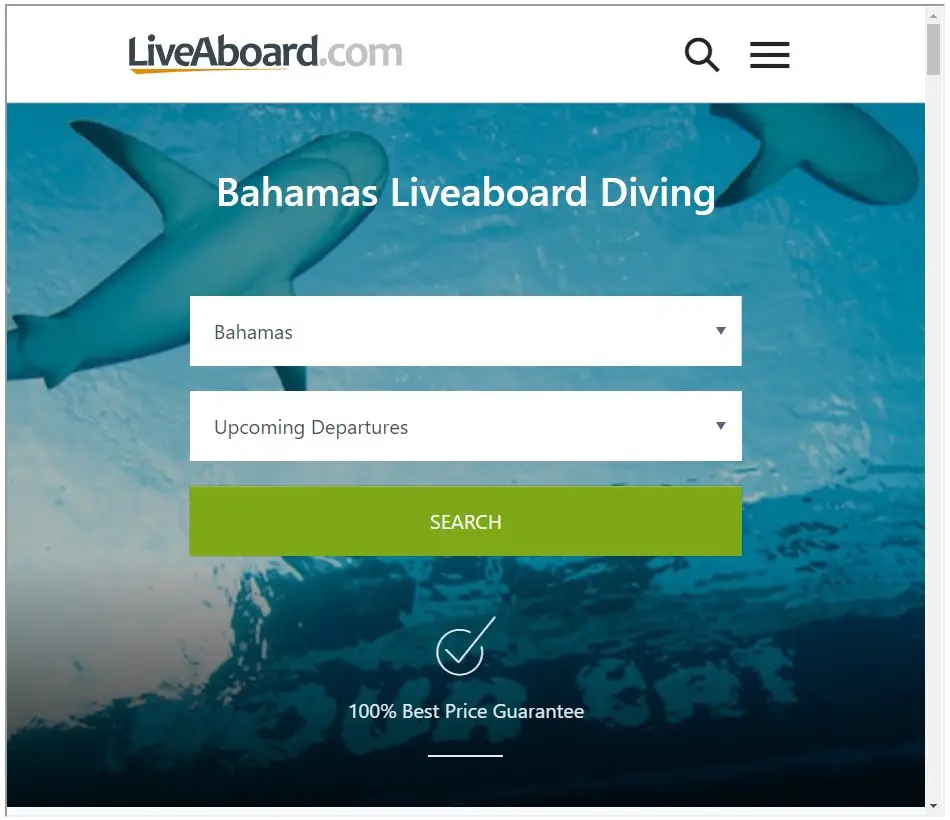
The best Bahamas liveaboard review
Now to the best Bahamas liveaboard dive boats. Use this handy table to sort these Bahamas liveaboards in order or review rating daily trip cost and more.
Handy Bahamas liveaboard comparison chart - Table of the best Bahamas diving liveaboards (Scroll table right for more info.)
| Bahamas Liveaboard | Review Rating Out of 10 | Cost Per Day (From price) | Enquire | Flexible Booking | Nitrox | Logged Dives/Min dive certification | Internet Cost (From price) | Available for Charter | Sidemount/Rebreather Diving support | Length | Max Guests/ Cabins/Bathrooms | Family cabins | Tiger Beach |
|---|---|---|---|---|---|---|---|---|---|---|---|---|---|
| Aqua Cat Bahamas liveaboard | 9.2 | £171/$233/€192 | Enquire | Yes | Paid | 000 - OW | No | Yes | Sidemount | 31m/102f | 30/11/13 | Yes | No |
| *** Editors Choice*** Bahamas Master liveaboard | 9.0 | £272/$370/€305 | Enquire | Yes | Paid | 050 - AOW | No | Yes | Rebreather Support | 35m/115f | 16/8/8 | No | Yes |
| Bahamas Phoenix Liveaboard | 8.5 | £164/$223/€184 | Enquire | Yes | No | 000 - OW | Paid | Yes | None | 14m/46f | 08/4/4 | No | No |
| Blackbeards Morning Star liveaboard (budget friendly) | 9.2 | £107/$146/€120 | Enquire | Yes | No | 000 - OW | No | Yes | None | 20m/65f | 24/9/3 | No | No |
| Blackbeards Sea Explorer liveaboard (budget friendly) | 9.2 | £107/$146/€120 | Enquire | Yes | No | 000 - OW | No | Yes | None | 20m/65f | 18/9/3 | No | No |
| Bahamas Cat Ppalu liveaboard | 0.0 | £185/$252/€207 | Enquire | Yes | No | 000 - OW | No | Yes | None | 20m/65f | 12/6/2 | No | No |
| Bahamas Aggressor liveaboard (formally the Carib Dancer) | 8.7 | £191/$260/€214 | Enquire | No | Paid | 000 - OW | Paid | Yes | None | 31m/100f | 14/6/9 | No | Yes |
The best Bahamas liveaboard comparison chart notes:
1. The exchange rate used for GBP to USD 1.36 and GBP to Euro 1.12.
2. The 'Cost per day' column will make it easy to sort these Bahamas liveaboards by cost, but these prices may vary when you visit to book. The prices listed are a cost guide and were correct at the time of compiling this table.
3. Under review rating '0.0' means no rating received at the time of compiling the table.
4. To scroll on desktop select table and use arrow keys. On touch screen including mobile devices scroll the table using the screen.
5. Min dive certification: OW = Open Water Diver. AOW = Advanced Open Water Diver.
Now for a full review of one of the most popular boats in the region. One of the best Bahamas liveaboard is the Bahamas Aggressor.
At a glance the Bahamas Aggressor liveaboard dive boat offers the following features:
- The Bahamas Aggressor is 30 metres (100 foot) in length and is a mono-hulled motor yacht.
- The Aggressor cruises Nassau, The Exumas and Grand Bahama.
- Maximum number of guests is 14, which allows for personal attention and ensures only a small group of divers on each dive site.
- All dives are done from the mother ship and the maximum dives for a 7 night trip are 22 and for a 10 night trip is 38 dives.
- There’s nitrox on board at an additional charge and there’s a photo and video editing center in the saloon for the keen underwater photographers on board.
- Recommended to wear a 3 to 5 mm full length wetsuit for Bahamas water temperatures.
- There are two hot showers for rinsing off after each dive.
- All the Aggressor’s cabins have en-suite bathrooms.
- There’s always plenty of tasty food on board, which features a variety of American dishes, BBQs and local specialties. Breakfast and lunch is buffet style, whilst dinner is full service. With homemade bread and desserts made every day to enjoy.
- Price includes a limited selection of local beer and wine, which is unusual for liveaboard trips. Plus included in the price are fruit juices, soft drinks, iced water, iced tea and coffee.
- TV, DVD, music system and air conditioning in the saloon and dining area, plus there’s even a hot tub on the sun deck.
- Run by an SSI dive centre.
- Runs Saturday to Saturday out of Elizabeth on the Bay Marina in downtown Nassau. The last Friday of the trip is spent in port and the evening meal is to be bought in Nassau, but the crew is there to help with dinner reservations and local transportation. The location of the docking is near to Bahamas International Airport.
Bahamas Aggressor liveaboard dive boat reviews
The Bahamas Aggressor scuba diving boat cruises around the best dive sites of the Bahamas.
Examples of Bahamas Aggressor reviews:
“Everything about my trip was extraordinary, especially the crew, it was a great adventure! The highlights of my trip involved the incredible amount of caring, support and goodwill that the crew exhibited during the entire trip…this involved all aspects ranging from the diving, accommodations, and food. Every member of the crew was there for us in every way…I consider this trip as one of my greatest adventures.” Recommended for: The crew was amazing, entirely sincere, the diving was superb and the food fantastic!
Bahamas Aggressor review from Daniel from the United States – Liveaboard.com
“Spectacular. Swim throughs, shark dive, spectacular reefs, petting a grouper, swarming sergeant majors, great food – I ate my way across the Caribbean.” Recommended for: Swim throughs. friendly sharks and grouper, great crew.
Bahamas Aggressor review from Michael from the United States – Liveaboard.com
Click this link for more information on booking your liveaboard dive trip to the Bahamas.
There are a few reviews on Trip Advisor on the Bahamas Aggressor. At the time of writing this review, all rate it ‘Excellent.’
For a taste of what it’s like to dive from the Bahamas Aggressor, here’s a video of a 7-day dive trip:
Week long liveaboard dive adventure. Aggressor Bahamas October 28 to November 3.
Booking your Bahamas liveaboard dive trip
Liveaboard operators in the Bahamas are in demand and low in number. This means that availability can be an issue. That’s why Liveaboard.com recommend you book 12 months in advance of your trip.
Best weather to visit to experience a Bahamas liveaboard scuba diving trip
The warmest time to visit the Bahamas is during the summer months, which are between June to September. The seas are calmest and at their clearest during this period. So great for a liveaboard scuba diving trip.
But watch out for hurricane season.
Hurricanes in the Caribbean can hit at any time between 1st June to 30th November each year. They’ve even been known to form as early as May too. So if you want to visit between these months be aware that your scuba diving may be adversely affect too. But it’s cheaper to scuba dive during hurricane season.
Of all Caribbean Islands The Bahamas has the highest frequency of hurricanes in the region. But history has shown that the most frequent occurrence of hurricanes in the Caribbean basin is in October. Some years are better than others, with other years when the Caribbean is hit by multiple hurricanes.
Therefore, when you are booking your Bahamas liveaboard trip be aware of hurricane season. But if you’re looking for a bargain Bahamas liveaboard trip, when it’s cheaper to book your scuba diving holiday, don’t let hurricane season stop you from booking your trip.
If you love scuba diving with sharks the best time to see sharks is between June and October (i.e. prime hurricane season). See below for more information of what to expect to see when you scuba dive the Bahamas.
Advantages of liveaboard scuba diving in the hurricane season
There are advantages of diving in the Bahamas during the hurricane season. These include:
- During this season there are less travellers and scuba divers visiting the region.
- The consequence of this is prices are cheaper.
- It’s a great time to dive as the wildlife is worth the trip, see below for more about what to see in the Bahamas below.
- If you prefer to dive on uncrowded dive sites, it’s certainly worth considering booking your Bahamas liveaboard dive trip during the hurricane season.
Take out travel insurance to protect your scuba diving trip
To protect your holiday I suggest you take out travel insurance. This is just in case your trip is delayed or cancelled as a result of a hurricane forming in the region.
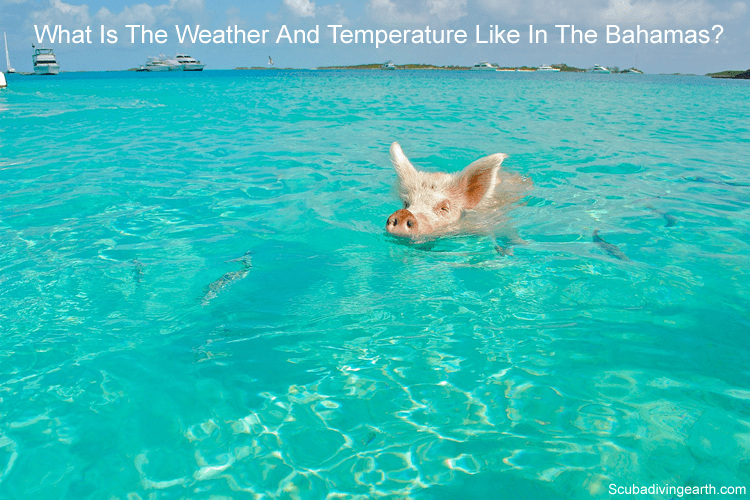
What is the weather and temperature like in the Bahamas?
The air temperature in the Bahamas ranges from a warm 17.3°C (63.1°F), through to a tropical 32.1°C (89.8°F). Whereas the water temperature in the region ranges from warm to lovely and warm. Which is converted into numbers as 23°C (73°F) to 28°C (82°F).
Water temperature fluctuations in the Bahamas
The water temperature in the Bahamas is higher during the period May to October, which is the high hurricane season. During this period you’ll probably experience water temperatures in the high 20’s °C (low 80’s °F).
Whereas in the period from November to April the water temperature drops to low-mid 20’s °C (low-mid 70’s °F).
Air temperature in the Bahamas
The air temperature follows a similar pattern to the above water temperatures. Where in the period April to October, the average high air temperature is in the range of 27-32°C (82-90°F). But in the period November to May the average high air temperature ranges between 25-27°C (77-82°F).
Rain in the Bahamas
The rainy season in the Bahamas is between May and October, with June and August having the highest average precipitation in this period. During this time, it usually only rains around once a day. Often the rain falls at night too, so can have no affect on the daytime part of your trip.
The rain is warm and is sometimes a welcome change to cool you down. It really only rains for short burst too. Often the rain is over almost as quickly as it began. Most Caribbean Islands I’ve visited they call the rain ‘liquid sunshine,’ as it’s warm and sometimes very much welcomed by the locals.
But then you’re going to get wet scuba diving in any case, so a bit of rain never did any harm.

Best time to scuba dive the Bahamas
The best time to scuba dive the Bahamas from a liveaboard dive boat depends on what you like to see. The dive season in the Bahamas is a year-round season. As already explained the temperatures is good enough for year-round scuba diving.
The worst case scenario is that you have to wear a slightly thicker wetsuit in the cooler water temperature periods.
Scuba diving during the summer months in the Bahamas – June – September
The summer months for the Caribbean are between June and September. This is when the seas are at their calmest (except when a hurricane hits). This is also when the visibility is at its best too.
But after a hurricane has swept through the region, it takes a few days for the visibility to return. The seas get pretty stirred up during a hurricane.
Scuba diving during the winter months in the Bahamas – October – May
The winter months in the Caribbean are between October to May. But winter in the Caribbean is still relatively warm when compared to northern America and the UK. This includes the islands of the Bahamas.
When compared to the winter months of the UK or the colder climes of the USA, the Bahamas are lovely and warm. In fact many Americans and Brits flock to the Caribbean between November and March/April.
The seas still have excellent water visibility for scuba divers in the winter months too.
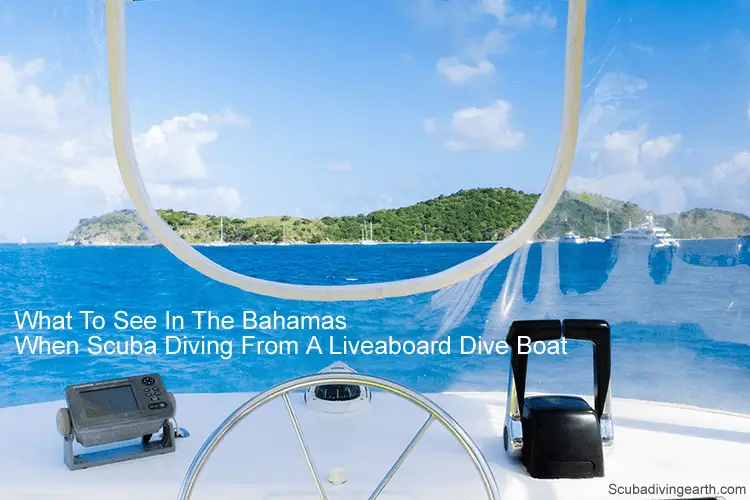
What to see in the Bahamas when scuba diving from a liveaboard dive boat
The Bahamas diving offers:
- Great ship wrecks.
- Some of the best shark diving in the world.
- Healthy coral reefs abundance with sea life.
- Stunning sea walls and exhilarating drift dives.
- The Bahamas offer an opportunity to dive the Atlantic from its East coast or the Caribbean sea from the west coast.
- Scuba diving in the Bahamas provides the opportunity to experience deep drop-offs, blue holes, caves and historical wrecks.
I experienced some of my best shark diving in the Bahamas. On one dive I lost count of the number of reef sharks I saw.
An abundance of sharks indicates that the reefs are healthy and strong. Sharks are apex predators and rely on an abundance of sea-life to feed upon. Only healthy coral reef systems support this type of ecosystem, which is great to see and experience.
The best times to see wildlife in the Bahamas scuba diving
Depending on your preference of what you like to experience when you scuba dive, here’s a summary of what to expect. But always remember, this is nature and nature has a habit of surprising you. This is only therefore a guide to when you may see certain types of sea life when you dive from your liveaboard boat.
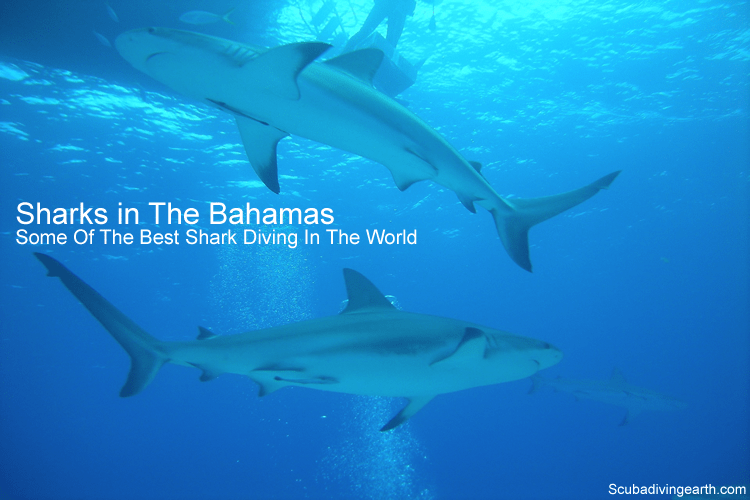
When is the best time to see sharks in the Bahamas?
The Bahamas offers some of the best shark diving in the world. Sharks can be seen year-round, but during the season June to October sharks are more prolific. Also, if you want to see Tiger Sharks the Bahamas liveaboard dive boats visit Tiger Beach to see tiger sharks around May to July.
The best time to scuba dive with oceanic whitetips in the Bahamas is between March and June.
If you’ve always wanted to see the infamous whale shark these also frequent the region around the Bahamas. Although you would be very lucky to see a whale shark in the Bahamas. Your best chance to spot a whale shark is on a Bahamas liveaboard boat trip. The season when there’s the chance of spotting a whale sharks in the Bahamas are January and February, and possibly December.
If you love shark diving you will still get to experience plenty of the many types of reef sharks. You can also see lemon sharks, nurse sharks and on occasion bull sharks in the region too.
When is the best time to dive with Rays in the Bahamas?
The Bahamas is a great place to scuba dive with rays. Rays seen in the region for most of the year. These include spotted eagle rays, various types of stingray and even giant manta rays too.
Manta rays are rarely seen in the Bahamas, but if you’re lucky enough to see one it’s more likely to be in July and possibly June.
When is the best time to scuba dive with whales in the Bahamas?
If you want to have the chance of scuba diving with whales in the Bahamas this is more likely during the months of December to May. They are sometimes seen in the other months, but less frequently.
There are many types of whale species encountered in the Bahamas, which includes the mighty humpback whale, minke whales and sperm whales.
There are also many types of dolphin too, which include the common bottlenose dolphin, the Atlantic spotted dolphin and the Risso’s dolphin. Dolphins of one type or the other can be seen year-round.
Other creatures to experience and see in the Bahamas – includes turtles, seahorses and other coral life
The seas around the Bahamas are teaming with life. That’s why a Bahamas liveaboard trip is the best way to experience this. You are likely to encounter turtles year-round, seahorses year round, plus many other critters. April being the best time for macro enthusiasts.
May is an active period for fish and coral spawning. But this is a phenomenon rarely experienced by scuba divers.
Handy Table of The Best Time To Dive The Bahamas (Scroll table right for more info.)
| Month | Weather | Average daily max temperature/ sunshine | Average Water Temperature | High/Low Season | Visibility | Exposure suit minimum | Average rainfall mm/In | Comments |
|---|---|---|---|---|---|---|---|---|
| 01. Scuba diving The Bahamas January | Dry season. | 26°C (78.8°F) - 7hrs | 25°C (77°F) | Peak | 30 metres (98 feet) year-round visibility. | Thin wetsuit | 70 (2.76) | Best for Whale Sharks. Possible whale sightings. |
| 02. Scuba diving The Bahamas February | Dry season. | 27°C (80.6°F) - 8hrs | 25°C (77°F) | Peak | 30 metres (98 feet) year-round visibility. | Thin wetsuit | 70 (2.76) | Best for Whale Sharks. Possible whale sightings. |
| 03. Scuba diving The Bahamas March | Dry season. | 27°C (80.6°F) - 9hrs | 25°C (77°F) | Peak | 30 metres (98 feet) year-round visibility. | Thin wetsuit | 70 (2.76) | Best for Oceanic Whitetips. Possible whale sightings. |
| 04. Scuba diving The Bahamas April | Dry season. | 29°C (84.2°F) - 10hrs | 26°C (78.8°F) | Peak to mid-April | 30 metres (98 feet) year-round visibility. | Thin wetsuit | 80 (3.15) | Best for Oceanic Whitetips. Possible whale sightings. Best for macro enthusiasts. |
| 05. Scuba diving The Bahamas May | Hurricanes are possible. Dry season. | 30°C (86°F) - 10hrs | 27°C (80.6°F) | Low | 30 metres (98 feet) year-round visibility. | Thin wetsuit/shorty | 160 (6.3) | Best for Oceanic Whitetips. Best for Tiger Sharks. Possible whale sightings. Fish and coral spawning. |
| 06. Scuba diving The Bahamas June | Hurricane season. Dry season/beginning of wet season. | 32°C (89.6°F) - 10hrs | 28°C (82.4°F) | Low | 30 metres (98 feet) year-round visibility. Visibility will be affected after a hurricane. | Lycra/Thin wetsuit/shorty | 180 (7.1) | Best for Oceanic Whitetips. Best for Tiger Sharks. Possible Manta Ray sightings. |
| 07. Scuba diving The Bahamas July | Hurricane season. Wet season. | 33°C (91.4°F) - 10hrs | 29°C (84.2°F) | Low | 30 metres (98 feet) year-round visibility. Visibility will be affected after a hurricane. | Lycra/Thin wetsuit/shorty | 220 (8.66) | Best for Tiger Sharks. Possible Manta Ray sightings. |
| 08. Scuba diving The Bahamas August | Hurricane season. Wet season. | 33°C (91.4°F) - 10hrs | 29°C (84.2°F) | Peak (School hols) | 30 metres (98 feet) year-round visibility. Visibility will be affected after a hurricane. | Lycra/Thin wetsuit/shorty | 200 (7.87) | Note high storm risk. |
| 09. Scuba diving The Bahamas September | Hurricane season. Wet season. | 32°C (89.6°F) - 8hrs | 29°C (84.2°F) | Low | 30 metres (98 feet) year-round visibility. Visibility will be affected after a hurricane. | Lycra/Thin wetsuit/shorty | 200 (7.87) | Note high storm risk. |
| 10. Scuba diving The Bahamas October | Hurricane season. Hurricanes most likely. Wet season. | 31°C (87.8°F) - 8hrs | 28°C (82.4°F) | Low | 30 metres (98 feet) year-round visibility. Visibility will be affected after a hurricane. | Lycra/Thin wetsuit/shorty | 140 (5.51) | Note peak storm risk. |
| 11. Scuba diving The Bahamas November | Hurricane season. End of rainy season. | 28°C (82.4°F) - 8hrs | 27°C (80.6°F) | Low | 30 metres (98 feet) year-round visibility. Visibility will be affected after a hurricane. | Lycra/Thin wetsuit/shorty | 100 (3.94) | Hammerheads and other migratory sharks arrive. |
| 12. Scuba diving The Bahamas December | Dry season. | 27°C (80.6°F) - 7hrs | 26°C (78.8°F) | Peak | 30 metres (98 feet) year-round visibility. | Thin wetsuit | 80 (3.15) | Best for Whale Sharks. Possible whale sightings. |
1. The best diving in the Bahamas for tiger sharks is May to July.
2. Average air temperature information from: https://www.timeanddate.com/weather/bahamas/nassau/climate
3. Average daily sun and rainfall and water temperatures are from: https://www.holiday-weather.com/nassau/averages/
4. To scroll on desktop select table and use arrow keys. On touch screen including mobile devices scroll the table using the screen.
Where to meet your Bahamas liveaboard dive boat and what to expect
Bahamas liveaboard dive boats depart from Elizabeth on Bay Marina in downtown Nassau. This is not too far from Nassau International Airport too.
Dive depths are between 6-40 metres (19-130 feet). Diving visibility is between 15 to 30 metres (50-98 feet). The currents are mild to moderate in the region. But if you dive The Washing Machine at Exumas the currents are much stronger (see below).
The surface conditions are mostly calm with some swell depending on the time of year. It can get choppy during storms.
Divers include beginner scuba divers through to advanced divers and it’s recommended to stay for between eight and 12 days.
What are the best dive sites of the Bahamas?
Here’s a quick summary of some of the dive sites you could experience on a liveaboard dive trip to the Bahamas.
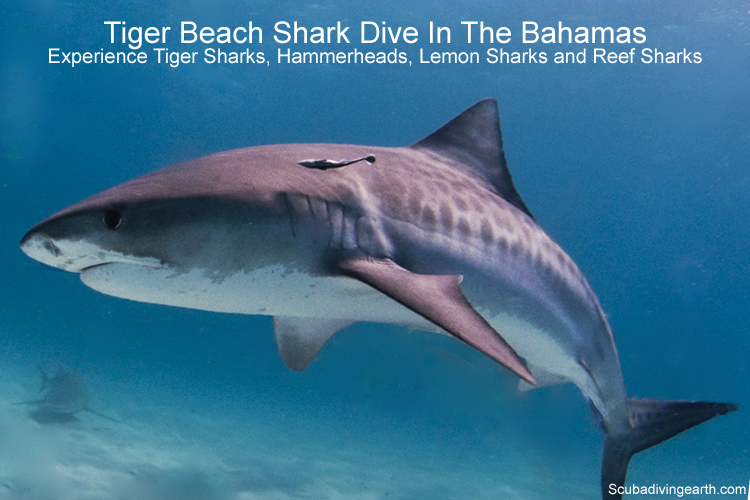
Bahamas Tiger Beach shark dive
The tiger beach shark dive is not to be missed. Tiger sharks are a formidable shark and can grow to over 5 metres (16 foot 5 inches). But tiger sharks are not the only sharks to visit this dive site. Tiger Beach is also known for scuba diving with hammerhead sharks, lemon sharks, nurse sharks and Caribbean reef sharks too.
To experience the Tiger Beach dive is worth the trip to the Bahamas on its own. You’ll experience the thrill of diving with a number of sharks in perfectly natural conditions. Although the feeding part is not so natural I have to say.
The dive itself is on a sandy bottom. The depth of the dive is somewhere between 6 to 30 metres (20-100 feet). I guarantee your heart rate will increase. Your mouth may go dry, making it harder to breath from your dive regulator. But these feelings of danger and fear diving with sharks are well worth it.
All the divers excitedly line up behind the experienced feeder and wait for the show to begin, but in an organised and calm manner. The sharks appear from the blue, which are attracted to the fish-filled crate.
A video taster of the adrenalin rush of the Tiger Beach dive:
Diving with Tigers, Hammers, and Bulls at Tiger Beach in the Bahamas with Shark Diver Magazine aboard the Dolphin Dream Liveaboard.
Tiger Beach dive liveaboards table
This list of Tiger Beach liveaboards is in descending customer rating order, followed by Scuba Diving Luxury Rating (SDE Lux Rating, see below), so the liveaboards with the highest customer rating and the best SDE lux rating will be at the top of the list. If you want to change the list order, use the “Sort by” dropdown below.
| Discover Liveaboard | Customer Rating | SDE Lux Rating % | Flexible Booking | Dive Courses | Dietary Requirements | Nitrox | Gear Rental | |
|---|---|---|---|---|---|---|---|---|
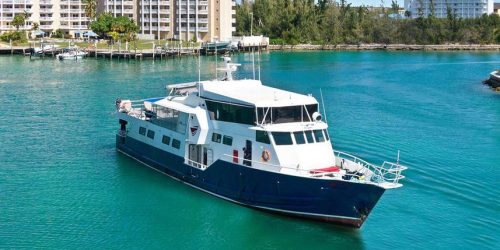 |
Review: MV Bahamas Master; Book: MV Bahamas Master | 9.2 | 73% | YES | YES | YES | YES | YES |
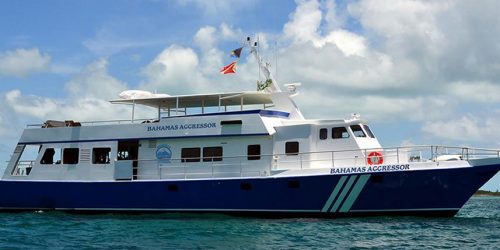 |
Review: MV Bahamas Aggressor; Book: MV Bahamas Aggressor | 8.6 | 67% | NO | YES | YES | YES | YES |
The Scuba Diving Earth Luxury Rating (SDE Lux Rating) is explained on each liveaboard review when you click the “Discover Liveaboard” link, and is my own Liveaboard Luxury Rating I’ve assigned to all liveaboards. Choosing between liveaboards is helped by customer scores, and if you get stuck choosing between two or three liveaboards, where each one has a high customer score out of 10, you can use the SDE Luxury Rating to help narrow down your choice.
Think about it like using Booking.com when searching for the best hotel. Booking.com also use a customer score where each customer rates hotels out of 10. This is similar to the liveaboard customer rating, which is also rated out of 10. But let’s say you only like to stay in hotels rated 8 and above on Booking.com, but you also want the hotel to have WIFI or parking, or to have a swimming pool etc. The features each hotel has is usually secondary to the score out of 10.
The Bahamas Tiger Beach dive site has been rated as one of the best dives in the world.
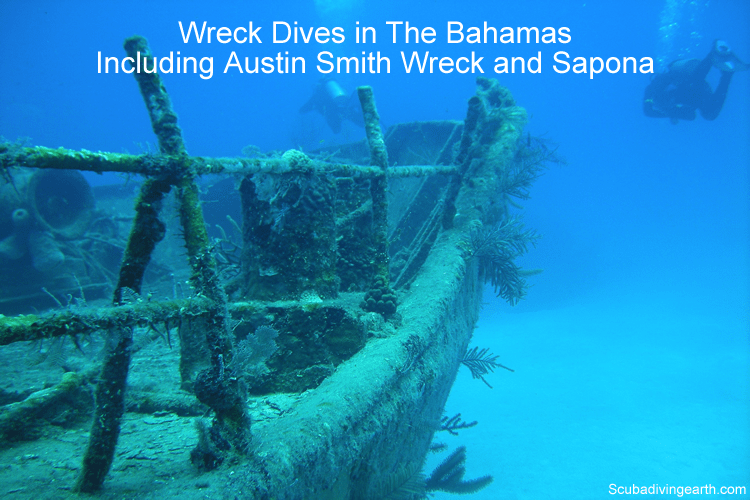
Wreck diving in the Bahamas
The Bahamas is known for its ship wrecks. If you are a scuba diver that loves to dive on wrecks, you won’t be disappointed when you visit the Bahamas. Bahamas ship wrecks include the Sapona and the Austin Smith wrecks.

S.S. Sapona wreck of the Bahamas
The S.S. Sapona is a famous wreck, which ran aground in a hurricane in late 1920 and now lies off the coast of South Bimini.
This ship wreck is visible both above and below the waves. Whilst you may think that a lump of rusting metal above the surface is not a great site to see in the Caribbean waters, this mangled mess of iron becomes a divers delight under the waves.
The marine life that crowds this wreck is a sight to see. There’s a plethora of sea life that thrives around the old wreckage, making it a real octopuses garden of life.
This ship was used as a transport vessel during World War I, but was transformed into an illegal gambling and liquor club before it sunk. In its hey day it was around 82 metres in length (270 feet).
The dive is only at around 6 metres (20 feet), so an easy dive to do even for the less experienced scuba diver. But probably better experienced snorkelling due to how shallow the wreck is. Always remember that going deep does not mean going better. Sometimes shallow dives can be the best. In this case if you like sea life, you’re in for a treat and due to its shallow depth, the colours are not so diminished either.
Expect to see plenty of lobsters and other crustaceans, octopus, angel fish, grouper and a mass of other fish. You may even see turtles on this wreck too.
Diving Concrete Ship near Bimini and Diving for Conch at the end.
The Bahamas Austin Smith Wreck dive
The Austin Smith sank in 1995 whilst being towed to San Salvador. This wreck lies in 18 metres (60 feet) of water, so is also one for beginner divers too. It is possible to penetrate the Austin Smith, but it’s only advisable for the more experienced divers. Whilst the sea life is not as impressive as it is on the S.S. Sapona, you’ll still see plenty of sea sponges, sea fans and other corals that have inhabited the wreck’s structure.
The Austin Smith was a 27 metre (90 foot) Bahamian Defence Force cutter. The ship was deliberately sunk to form an artificial reef and was done so in memory of Bahamian marine Austin Smith.
Austin Smith wreck dive, Bahamas, Dec
The Lost Blue Hole dive of the Bahamas
The Lost Blue Hole is a must-do dive of the Bahamas and is literally a massive underwater hole at the bottom of the Caribbean Sea.
There are many scuba divers who travel to the Bahamas specifically to experience the Lost Blue Hole dive along with the Tiger Beach dive.
The blue hole itself is around 30 metres (100 feet) wide. The edge of the crater lies at around 12 metres (40 feet) of water and is over 60 metres (200 feet) deep. The visibility is usually amazing. But some have experienced less visibility, as the currents around the top of the hole can move the sand around. These currents will affect the water’s visibility into the hole itself.
All levels of divers can experience the hole, but not many will be able to dive to is base. Only advanced divers using air mixes will be able to dive to the bottom of the Lost Blue Hole. Beginner divers will only be able to venture into around 6-8 metres (20-26 feet), as the hole entrance is already at 12 metres deep.
The Lost Blue Hole is a submerged crater which is quite close to the shore. For those who want to experience their first sink hole, this might be the one to begin with. It’s not only a fascinating site, but unlike other blue hole dives, this hole is home to a variety of sea life, which includes common fish species including grouper, sting rays, angelfish, snappers, amber jack, and yellow tail.
The Lost Blue Hole is a natural hole in the open ocean floor about 100 feet across and over 200 feet deep. The perimeter of the hole is located in 40 feet of water.
The walls of this crater are home to many sea creatures
The walls of the Lost Blue Hole are littered with crevices and you may be lucky to spot the odd nurse shark or two hiding away here. Other marine life shelter in this hole away from outside currents.
Sea life you’ll experience at this dive site includes sharks, rays, turtles, and various pelagic fish. Most of the sea life is near to the top of the hole, but at around 25 metres (80 feet) into the hole, you find a large crevice which is home to a large number of lobsters too.
One of the best views is to look back up from within the Blue Hole, which is an amazing sight to see.
Amberjack Reef dive of the Bahamas
Amberjack reef was previously a shark feeding site. But after the Sea Park’s request sharks are no longer fed here. The seabed is at around 15 metres (50 feet), so a great dive site for all levels of scuba diver to experience. The visibility is usually around 30 metres (100 feet) for most of the year.
There’s a proliferation of reef sharks at this dive site, which is mostly Caribbean reef sharks. These will soon surround you as you descend to the bottom.
There are also yellowmouth, yellowfin grouper and barracuda that make this reef their home. This dive site is also home to many smaller sea creatures too. The smaller fish include the likes of angel fish, parrot fish and many other common reef fish too. The sandy parts of the seabed are home to garden eels, which you’ll see pop their heads out when they don’t feel threatened.
The Bahamas Shark Paradise and Fish Tales dive sites
These two dive sites are famous for shark encounters. They are quite close to one other, but you will normally dive Fish Tales as it is the deeper of the two dives, followed by Shark Paradise.
Fish Tale’s is frequented by many sharks and you can often see lemon sharks, Caribbean reef sharks and also tiger sharks here.
Dykkertur med kingfish.dk ved Little Bahamas Bank – Fish Tales – tigers sharks.
The dive does involve a descent to the bottom alongside these various shark species. But these sharks are more than happy to accommodate you in their home without any problems. You may or may not be pleased to know that the tiger sharks tend to keep their distance from scuba divers.
The reef itself has colourful gorgonians, sea fans and orange spiny sea rods amongst other coral formations.
The Bahamas Bull Run dive site
The Bull Run is another famous and much-loved Bimini dive site. The dive site consists of three large pinnacles reaching up out of a sandy seabed. There are many swim-throughs and coral caves that you can experience at this site, if you’re not confined to a shark cage.
The name of the dive is because you can sometimes see bull sharks in the area. But more common and seen on almost all dives at The Bull Run are blacktip reef sharks. But you may also encounter lemon sharks and the mostly docile nurse sharks too.
Due to the large proliferation of sharks in this region, some operators only offer this dive site as a cage diving experience. It’s when the bull sharks appear that many of the scuba divers take refuge in the shark cages, as they have a reputation of being an aggressive shark.
Curious reef sharks at the Bull Run dive site Taken in May during a diving week aboard the Juliet
The Bahamas Washing Machine Exumas dive
One of the most beautiful island groups in the Bahamas is the Exumas. This group of islands is made up of around 350 cays, which is surrounded by stunning beaches, waterways and reefs.
The Exumas are home to the Bahamas National Trust’s Land and Sea Park. But outside the park to the northern section of the Exuma Cays is a site known as the Washing Machine.
This is a shallow drift dive that begins in only about 4-5 metres (15 feet) of water. Divers are dropped down to a strong current, which picks them up and propels them through a narrow cut in the reef. Sometimes divers are washed around and end up going head over heels, hence the name “The Washing Machine.”
Out the other side of the narrow cut in the reef, the divers are now at around 15 metres (50 feet). Still moving along in the current, they are now floating over a beautiful and colourful reef.
Here’s a video of The Washing Machine – enjoy:
This was a fun and thrilling dive! .
Wax Cay Cut Drift – Exuma Cays Bahamas
If you love a fast drift dive, then the Wax Cay Cut is another example of a fast and shallow drift dive in the Bahamas.
There’s a chance of seeing nurse sharks, turtles, stingrays and barracuda in this area. Plus the usual corals and fish life you’d expect.
Here’s another video to take a peek at what to expect on this fast drift dive:
A drift dive through Wax Cay Cut, probably the fastest drift dive for the week. Saw a couple of nurse sharks, a turtle and a sting ray.
I hope you enjoyed this article about Bahamas liveaboard dive boats
I’d love to hear from you. Tell us about your adventures of diving and snorkeling, in the comments below. Please also share your photos. Either from your underwater cameras or videos from your waterproof Gopro’s!
If this article hasn’t answered all of your questions. If you have more questions either about snorkeling or scuba diving (or specifically about Bahamas liveaboard dive boats and Bahamas liveaboard scuba diving), please comment below with your questions.
There will also be many more articles about scuba diving (and snorkeling) for you to read and learn about these fabulous sports.
Have fun and be safe!

